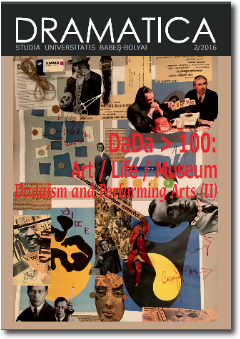EDWARD GORDON CRAIG, UN DADAÏSTE MALGRÉ SOI ?
EDWARD GORDON CRAIG, A DADAIST WITHOUT KNOWING IT?
Author(s): Anca MăniuţiuSubject(s): Fine Arts / Performing Arts
Published by: Studia Universitatis Babes-Bolyai
Keywords: Craig; Dadaism; Futurism; experimental plays.
Summary/Abstract: Edward Gordon Craig, a Dadaist without Knowing It? Edward Gordon Craig (1872-1966), actor, director and set designer, one of the founders of modern scenography, well known for his radical theory about the replacement of the actor by a mysterious inanimate figure, clothed with “a death-like beauty” and called the Über-marionette, left a legacy of thousands of pages of unpublished manuscripts and drawings that started to be explored by researchers only recently. Some of the manuscripts located in the Craig Collection at the Institut International de la Marionnette are notes and plays for marionettes (finished or unfinished), that Craig intended to gather in a volume under the title The Drama for Fools. A group of French researchers published in 2012 a remarkable bilingual edition of the finished plays and the texts related to them. These texts give us a very different image of Craig, the symbolist who professed the Mystic of Art and yearned for the Ideal Beauty. The article analyses one of these plays, entitled Romeo and Juliet, written in 1918, which is embracing alogical dramatic strategies, similar to those used by the Futurists and the Dadaists. Like them, Craig is appealing to grotesque and absurd, to the carnivalesque reversal of the traditional dramatic categories and conventions, realizing an iconoclastic and parodical rewriting of the canonical text. Our article is trying to point out the similarities between Craig’s aesthetic approach and attitude and those of the Futurists and Dadaists at the same epoch.
Journal: Studia Universitatis Babes-Bolyai - Dramatica
- Issue Year: 61/2016
- Issue No: 2
- Page Range: 103-117
- Page Count: 15
- Language: French

